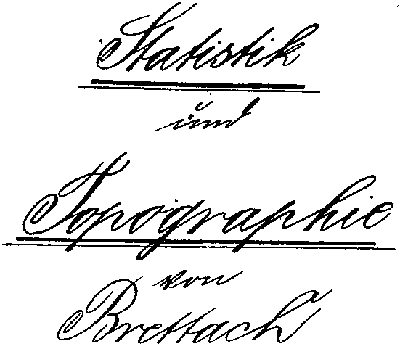In the housing area, „Stadthohle III“ in Brettach there has existed
for some time a Franz Häfelin street. Interested citizens aften ask
who was this obviously famous man.
The idea that it could be the name of a poet, musician, politician,
or some other regionally famous man isn’t true. Franz Häfelin lived
and worked in Brettach for decades. When there was a new search for suitable
names for new streets it was decided by the council, after very detailed
research, to give Franz Jakob Häfelin the posthumous honour of having
a street in Brettach named after him.
In the fist half of the previous century Franz Häfelin was Mayor
and Town Clerk of Brettach. Together with these offices, and over and above
the duties of his occupation, he was an historian. We are thankful to him
for the knowledge of local history, and not just for that of the 19th century.
Franz Jakob Häfelin was born on 25.7.1785 in Weiler near Löwenstein.
He was the son of school teacher Johann Jakob Häfelin. We know
nothing of his chiuldhood. On 23.11.1817 he married Sophie Elisabeth Ehmann
(from „Schlössles“ Ehmann) of Brettach. He lived with his family in
house No 44 near the old Brettach council building, the present community
hall. Franz Häfelin died 21.1.1868.
Franz Häfelin was, beside his official duties , as side interests
a historian, a farmer, and with total commitment a grapegrower. As such
he was specially succesful. Because of his theoretical ideas and practical
results in grape growing he received wide praise and even an honour from
the state.
In 1815 Franz Häfelin was elected mayor and town clerk of Brettach.
He held this office till 1837. From 1837 to 1861 he was town clerk in Brettach
and occasionally also for several neighbouring villages.
During his 22 full years of service as Mayor he not only had his normal
duties, but also, as is usual for Mayors of all times, his problems. From
Häfelins time of office we have an example of the history of buildings
in the village. Soon after becoming Mayor he was informed of the disrepair
of the Brettach school which stood next to the manse on the present site
of the church hall. He strongly urged the total demolition of the old building
and erect a new one. His demand created huge disagreements within the council
and between him and council members. Finally, however, the old school was
torn down in 1820, and as is said, „despite much annoyance and the contradiction
of troubled times“ (money shortage), a new school was built for 2500 guilders.
Obviously after the Napoleon wars and the famine of 1816/17 a new school
did not seem necessary for many in Brettach. In any case for many farmers
the help of children at home was often more important than going to school.
Some poorer farmers were not even able to pay the school fees for their
children. And now they feared likely higher taxes. It was not easy for
Häfelin to explain to people that better school conditions were necessary
for the future of their children.
Häfelin’s achievements are valuable in that he was able to see
beyond his local secretarial duties in Brettach. During his 46 years in
the village he understood situations accurately.
His writings are a storehouse of local history.
In his book, among other things, he explains the current
situation of the village:
|
 |
- Outline of Local History. (“Entwurf einer Ortschronik").
Here Häfelin tried to write a history from the birth of Christ till
about 1850. In a broad sweeping overview we get weather observations and
grain prices, which he would have found among the records of the old Brettach
council buildings. Alongside the interesting local historical traditions,
the remaining historical facts are mostly always correct.
All in all the Häfelin records are a valuable source of local
history. Because of Häfelin the knowledge of local history before
the 19th century has partly survived, because we know that all the documents
which lay in the old council building were destroyed in 1945.
We also acknowledge that some nice poems have survived. In his “Topography“
Häfelin has given the following motto:
| At all times history has been
the truest teacher of mankind she still is, and will continue to be. Blessed is he who listens to her warning and follows her wise teaching (Häfelin)
In the light of the past150 years of German
|
 |
aus "Rückblicke" des Heimatgeschichtlichen Vereins Langenbrettach
e.V. [Nr.61]
Translated by S.M.Simpfendörfer.